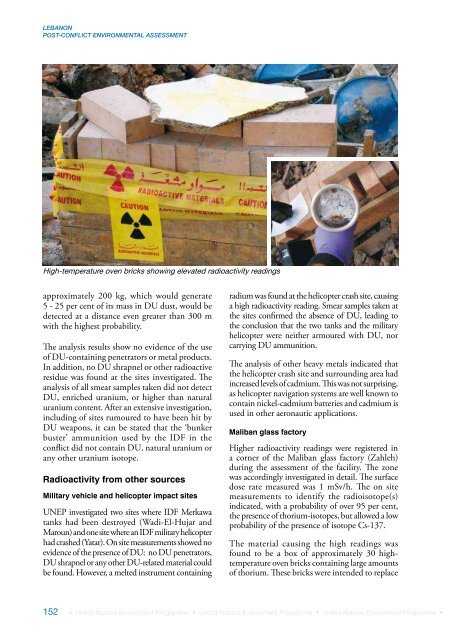Lebanon Post-Conflict Environmental Assessment - UNEP
Lebanon Post-Conflict Environmental Assessment - UNEP
Lebanon Post-Conflict Environmental Assessment - UNEP
Create successful ePaper yourself
Turn your PDF publications into a flip-book with our unique Google optimized e-Paper software.
LEBANONPOST-CONFLICT ENVIRONMENTAL ASSESSMENTHigh-temperature oven bricks showing elevated radioactivity readingsapproximately 200 kg, which would generate5 - 25 per cent of its mass in DU dust, would bedetected at a distance even greater than 300 mwith the highest probability.The analysis results show no evidence of the useof DU-containing penetrators or metal products.In addition, no DU shrapnel or other radioactiveresidue was found at the sites investigated. Theanalysis of all smear samples taken did not detectDU, enriched uranium, or higher than naturaluranium content. After an extensive investigation,including of sites rumoured to have been hit byDU weapons, it can be stated that the ‘bunkerbuster’ ammunition used by the IDF in theconflict did not contain DU, natural uranium orany other uranium isotope.Radioactivity from other sourcesMilitary vehicle and helicopter impact sites<strong>UNEP</strong> investigated two sites where IDF Merkawatanks had been destroyed (Wadi-El-Hujar andMaroun) and one site where an IDF military helicopterhad crashed (Yatar). On site measurements showed noevidence of the presence of DU: no DU penetrators,DU shrapnel or any other DU-related material couldbe found. However, a melted instrument containingradium was found at the helicopter crash site, causinga high radioactivity reading. Smear samples taken atthe sites confirmed the absence of DU, leading tothe conclusion that the two tanks and the militaryhelicopter were neither armoured with DU, norcarrying DU ammunition.The analysis of other heavy metals indicated thatthe helicopter crash site and surrounding area hadincreased levels of cadmium. This was not surprising,as helicopter navigation systems are well known tocontain nickel-cadmium batteries and cadmium isused in other aeronautic applications.Maliban glass factoryHigher radioactivity readings were registered ina corner of the Maliban glass factory (Zahleh)during the assessment of the facility. The zonewas accordingly investigated in detail. The surfacedose rate measured was 1 mSv/h. The on sitemeasurements to identify the radioisotope(s)indicated, with a probability of over 95 per cent,the presence of thorium-isotopes, but allowed a lowprobability of the presence of isotope Cs-137.The material causing the high readings wasfound to be a box of approximately 30 hightemperatureoven bricks containing large amountsof thorium. These bricks were intended to replace152 • United Nations Environment Programme • United Nations Environment Programme • United Nations Environment Programme •
















